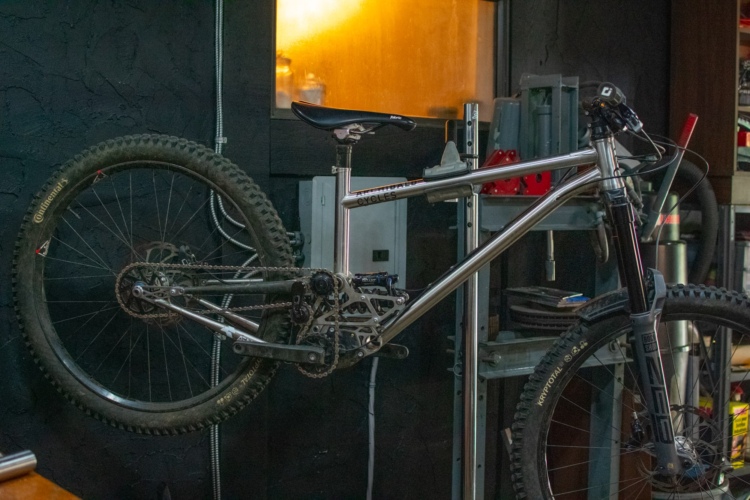
From Nate Zukas and his signature seatstays to Chris Currie and his bonded alloy frames, Singletracks has covered many custom frame manufacturers. It is always fun to see artists thinking outside the box, providing frame offerings that aren’t the same as every other mountain bike on the market.
“Outside the box” would certainly be an appropriate way to describe a new mountain bike frame manufacturer out of the Northwest that caught our attention. Along with photos that have been bouncing around on social media and sightings in the flesh at Sea Otter, Apogee Bikes has been turning plenty of heads with the unique design of their trail frame, the Apogee One, featuring a steel frame with a removable bottom bracket and linkage.
Singletracks caught up with some of the masterminds behind the Apogee and discussed their origins, frame and suspension design, and where they are heading as a brand.

Apogee’s Origins
If seeing a steel frame with a removable bottom bracket and linkage gives a feeling of deja vu, you might have seen this bike before. Earlier iterations of the Apogee One had the bike branded as the Albatross Apogee Module, a concept bike designed and developed by Will Hilgenberg, founder of Albatross Bikes.
Hilgenberg designed the Albatross Apogee to be a modular full-suspension mountain bike that is very customizable to the rider. With both the front and rear triangles able to detach from the bottom bracket and rear linkage, customers could customize their bikes to their liking—a shorter rear end, a longer front end, or vice versa.
Fast forward to the 2023 MADE Bike Show in Portland, Oregon, where Hilgenberg and his Apogee design partner, Collin Huston, had their Albatross Apogee on display. A third player in this Apogee story, Jake Webski, saw the bike and struck up a conversation with Hilgenberg and Huston.
As the conversation continued, stretching into the weeks and months that followed, the trio of Hilgenberg, Huston, and Webski began wondering if they had something bigger, something that could stand on its own. With Hilgenberg’s welding and design experience, Huston’s CNC machining background, Webski’s marketing expertise, and a few other talented friends, Apogee was evolving into more than just a bike in Albatross’ lineup.
Quickly, Apogee was becoming its own brand.

The Apogee One
When we caught up with Webski and Hilgenberg, many of the Apogee One’s details were still being worked out. As they continued to push their prototype Apogee through the testing process, the designers made minor adjustments to the future iterations.
While hammering down just exactly what they wanted out of the Apogee One, the team was able to share their current geometry numbers with me. While these numbers aren’t solidified, they feel like they are reaching a landing point with the geometry.
Currently, the Apogee One will be released in five size options—small, medium, medium/large, large, and extra large. The head tube angle will sit at 64°, with a seat tube angle (effective) of 78° across sizes, except for the M/L frame, which will have a seat tube angle of 77°.
Reach ranges from 440mm to 530mm, with that size M/L having a 470mm reach and an even 500mm for the size large. For now, chainstays appear to be at 440mm across sizes, although this was a place where the team has toyed with the idea of more customizability.
These numbers have changed a bit from the original geometry of the Apogee Module Hilgenberg had at MADE 2023.
“Something we learned from the very first proof of concept was…the head tube was too slack,” Webski shared. In riding and testing the Apogee One, the crew found they wanted a steeper head tube, which we can expect on their final bike. What precisely that head tube measurement is will remain a mystery for now.
Another thing we do know is that they have landed on travel numbers for the Apogee One. An early Apogee Instagram post shares that the One will be a 140mm travel platform paired with a 160mm travel fork. Webski and Hilgenberg confirmed these travel numbers haven’t changed.
Apogee doesn’t seem to be getting too far from its ability to be customizable, as Webski shared they hope to carry on Hilgenberg’s original thought of a modular full-suspension bike. “We’re looking at a few things there,” Webski shared. “First is the setup we want to run as a baseline.”
After the team establishes the baseline model, they can figure out what else makes sense for them to offer regarding customizability. Webski mentioned they are exploring a modular rear drop-out, allowing for adjustability on chainstay length and the ability to run a mixed-wheel setup.

The Apogee One is wrapping up its testing time and getting a few more refinements.
“With [Huston] and [Hilgenberg] having legitimate engineering experience, they’ve laid out a super dialed product development process,” Webski shared. “We’re going through FEA and ISO testing, revising things on the bike, troubleshooting the little details.”
Webski reported that the testing process has been going well, as they’ve already passed some stages and continue to plug along. He attributes this to Hilgenberg and Huston’s engineering and design skills. “It shows the quality of our two designers, and we were able to pass with flying colors.”
Free-Float Module Suspension Design
What makes the Apogee One so unique is what the brand calls its Free-Float Module (FFM). A single-pivot by nature, his bottom bracket/linkage combo looks miles away from the single-pivot images we are likely to have in our heads.
One thing the FFM does well is give the bike a lower center of gravity. Hilgenberg explained that the combination of components in the module, as well as any extra weight from pivot reinforcements, helps the Apogee One attain that low center of gravity.
For Hilgenberg, a lower center of gravity creates a more stable frame with higher levels of traction that is easier to ride. And with a low center of gravity, there is much less leverage at play to twist the bike out from under the rider when encountering technical sections of the trail.
Hilgenberg has been working on the modular suspension design for the last year and a half. “This design came from an effort to rethink what is important about a full suspension bike,” Hilgenberg said. “We wanted to design a bike that responded well to the trail and rider, and delivered a unique ride quality.”


The FFM suspension allows Apogee to create a frame that flexes where you want it to without compromising pivot alignment. Hilgenberg explained that while stiff modern frames help keep the pivot alignment intact, the result can be a harsh overall ride feel. Apogee fixes this issue by essentially separating the linkage from the frame.
“This allows us to build a very rigid and precise structure for the suspension module to control the linkage movement and still be free to design to whatever lateral stiffness we want in the front and rear subframes without affecting suspension performance,” Hilgenberg explained.
Hilgenberg and his team have designed the suspension module to be precise and rigid. They have then paired this with a steel frame that they feel offers an incredible ride feel and flex where you want it. Using steel has allowed them to design the Apogee One to have enough flex to help maintain control and generate more traction as you ride.
Keeping dirt and mud out of the Apogee’s FFM was another key component in the design and testing that they tackled. Debris came mostly from the tires, so guards were put in place in the front and rear of the module. The module was also intentionally designed with as much open space as possible to clear any debris.
“We also designed dust covers to prevent mud from getting directly into the bearings and have partnered with Enduro Bearings to make sure that we are using the most durable bearings possible,” Hilgenberg told us.
Apogee’s FFM suspension also allows for different sizes of front and rear triangles to be attached to the modular suspension without affecting pivot alignment. This means no changes to leverage curves, kinematics, or geometry. They can also change linkage components to make kinematic changes without affecting the geometry.
The team also loves that this modular design gives them tremendous freedom for the future. “Another benefit is that we can mix materials,” Hilgenberg said. “Right now, we are using aluminum for the module and steel for the front and rear triangles. But there is no reason we couldn’t offer titanium, magnesium, or any other frame materials.” They can also play with mixing materials, such as a steel rear triangle and a titanium front.
For now, the release of the Apogee One won’t be as customizable as Hilgenberg’s initial Albatross Apogee Module idea, where, for example, the rear triangle could be swapped out for another to get an ideal chainstay length. But the bike will be customizable nonetheless.
“Moving forward, we plan to use the modularity to permit upgrades to the kinematics, dropout changes, and frame material changes,” Hilgenberg explained. He also said the modular concept makes repairs much easier, with just part of a frame needing to be replaced.
“We have the freedom to continue to develop the platform and continue to provide value to our customers for years to come,” Hilgenberg told us.
For now, the guys behind Apogee will continue to keep their cards close. As we get closer to the official launch of the Apogee One, it will be interesting to see what the final bike looks like, its exact numbers, and the kinematics behind the FFM suspension.

And, could a gear box be in the future? The Apogee crew isn’t ruling it out!
“While we aren’t offering a belt drive or gearbox option at launch, the benefit of using this modular approach is that we can accommodate these kinds of upgrades in the future,” Hilgenberg explained. “There have been a lot of interesting developments of the belt drive/gearbox system in the last few years so we will be very interested to hear from our customers if this is something that they are interested in adopting.”
With the MADE Bike Show being the first place the three met and began to dream, they thought it was only fitting to make MADE the place to launch the Apogee brand fully. The Apogee One will be fully displayed at the 2024 MADE Bike Show.
There is an option to jump on a limited spring pre-order list on Apogee’s website. As far as getting the Apogee One to customers, the brand anticipates bikes being delivered to customers in October.





















2 Comments
May 31, 2024
May 31, 2024